Class A RVs are some of the largest and most well-equipped motorhomes available today, offering a wide range of standard features, including fully-equipped kitchens, bathrooms, multiple sleeping areas, heating, and cooling systems, and completely self-contained electrical and plumbing systems.
However, once you get past the basics of a self-contained RV, there can be a lot of differences in features from one Class A RV to the next, depending on its price point and overall size.
So we thought we would answer some of the most common questions about whether a particular feature is available or not on Class A RVs.
Do Class A RVs Have Generators?
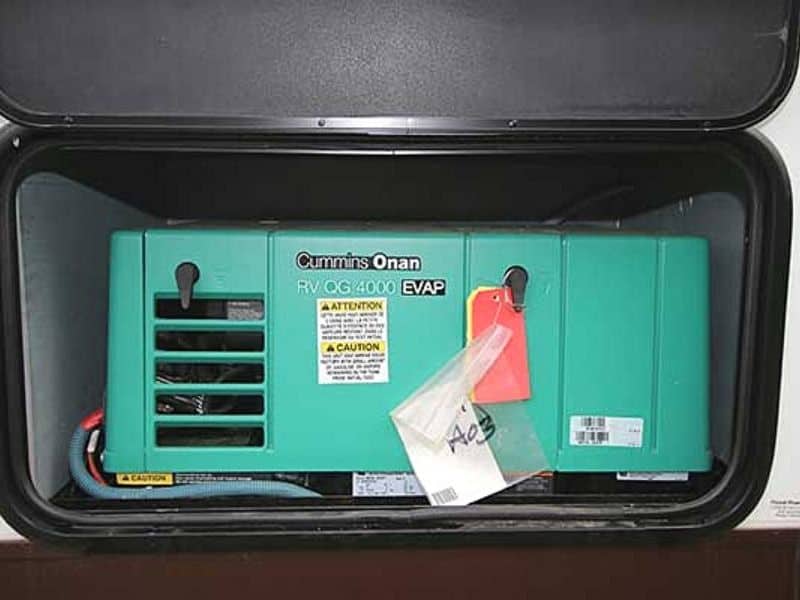
All Class A RVs have generators, however, the size, brand, and location of the generator can vary from one Class A to the next, depending on the motorhome’s price point, engine type, and engine configuration.
As smaller and less expensive Class A motorhomes will typically have smaller gas-powered generators, ranging in size from 4,000 to 8,000 watts.
While larger and more expensive Class A motorhomes will typically have larger gas or diesel-powered generators, ranging in size from 8,000 to 12,000 watts.
In addition, front-engine gas-powered Class A RVs will typically have generators located in a side exterior storage compartment.
While rear-engine diesel-powered Class A RVs will typically have generators located at the front of the RV under the windshield on a large slide-out tray.
Do Class A Motorhomes Have Airbags?
While you might naturally assume that Class A motorhomes like passenger vehicles come standard with airbags, surprisingly most Class A RVs are not equipped with airbags.
But why is this?
Why do Class A RVs not offer airbags?
Well for starters, unlike standard passenger vehicles, which are required by law to have multiple safety features including airbags, and required to go through rigorous crash testing from either the manufacturer or the National Highway Traffic Safety Administration (NHTSA), RVs, and motorhomes are exempt from most of these requirements and are not required to be crash-tested.
Largely leaving it up to the RV manufacturer’s discretion on which if any driving safety features that they install on their RVs.
Which is often very few, especially on smaller cheaper Class A RVs.
In fact, the few driving safety features found on Class A RVs are typically thanks to the Class A RVs chassis manufacturer, which is usually either Ford or Freighliner and not the RV manufacturer.
If there’s a silver lining to all this, however, it’s that this seems to be changing in recent years.
As safety-conscious consumers are demanding RVs and motorhomes to have the same safety features that they’ve come to expect from passenger vehicles.
Causing many RV manufacturers and RV chassis producers to include many advanced safety features on their latest RVs and chassis, such as electronic stability control, anti-lock brakes, lane departure warnings, and even automatic braking and forward collision avoidance systems.
For more information on Class A Motorhome safety, check out our article “How Safe are RVs: Things You Need to Know“.
Do Class A RVs Have Seatbelts?
Unlike airbags, the one safety feature that you can always count on in Class A RVs is seatbelts, as most Class A motorhomes will have at least four seats that are equipped with seatbelts, including the driver and front passenger seats.
However, just because the driver and front passenger seats of a Class A RV have seatbelts, don’t make the mistake of thinking that this means that every seat in a Class A motorhome will have a seatbelt.
As it’s not uncommon for Class A motorhome seating to lack seatbelts.
So if you’re planning to travel with more than four people in a Class A motorhome, make sure that the Class A motorhome you’re looking at has an adequate number of seatbelts for every occupant.
Otherwise, you might need to add an aftermarket seatbelt to the coach.
Do Class A Motorhomes Have Outdoor Kitchens?
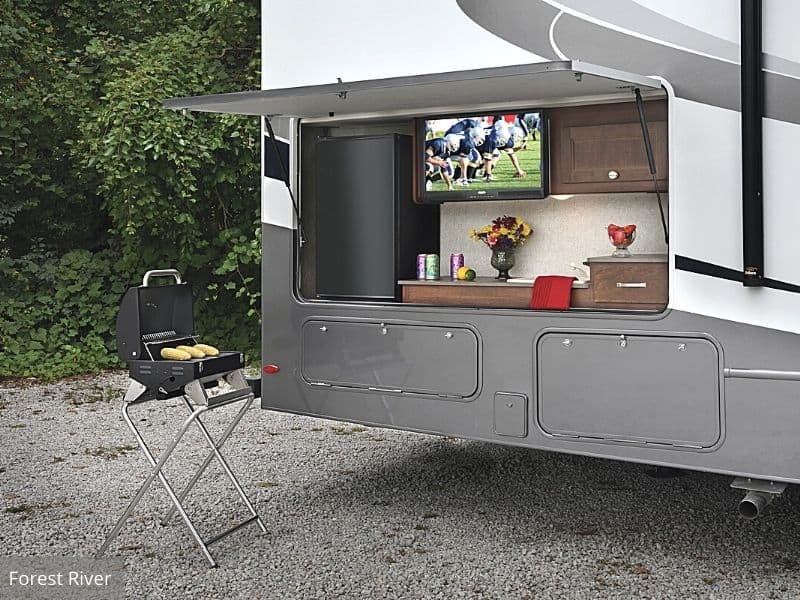
Outdoor kitchens are less prevalent on Class A motorhomes compared to other types of RVs, such as travel trailers and 5th wheels, however, there are a few Class A RVs that offer outdoor kitchens.
You might be wondering though, why outdoor kitchens are so rare on Class A motorhomes?
Well, it has a lot to do with where outdoor kitchens are generally located, as they’re typically found toward the rear of the camper, on the “camp side” of the RV.
Which is an area on Class A motorhomes that is often already claimed by other RV components, such as rear engines or spacious master bedrooms/bathrooms, which leaves little to no room for outdoor kitchens.
However, as mentioned above, there are a few Class A motorhomes that offer outdoor kitchens, which we’ve highlighted below.
Class A Motorhomes with Outdoor Kitchens
- Winnebago Vista 31B
- Thor Motor Coach A.C.E. 29.5
- Coachmen Pursuit 29SS
- Jayco Alante 29S
- Winnebago Adventurer 29B
- Holiday Rambler Admiral 29M
- Entegra Vision 29S
- Thor Motor Coach Hurricane 34J
- Coachmen Encore 325SS
- Thor Motor Coach Miramar 34.6
For more detailed information on these Class A RVs, check out our article “10 Must-See Class A RVs with Outdoor Kitchens“.
Do Class A Motorhomes Have Air Brakes?
The most common type of brakes found on motorhomes is hydraulic brakes, which are the same type of brakes used on most standard passenger vehicles.
However, not all motorhomes use hydraulic brakes, as larger diesel motorhomes, such as large Class A RVs and Super C RVs, will often use air brakes, which use air pressure as opposed to hydraulic pressure to apply the brakes.
Due to the fact that airbrakes offer numerous advantages over hydraulic brakes, especially when it comes to larger vehicles, which is why air brakes are governmentally mandated for vehicles exceeding a certain size or passenger-carrying capacity when used for commercial purposes.
Air Break Advantages
- More Reliable – Air brakes are generally more reliable compared to hydraulic brakes.
- Less Likely to Fail – Air brakes will function and operate even if there’s a minor leak in the system. Unlike hydraulic brakes, which will often fail even with a minor leak.
- Cheaper to Operate – Larger vehicles require more stopping power, which requires either more air or hydraulic fluid for braking. Making air brakes much cheaper to operate compared to hydraulic brakes, due to the fact that hydraulic fluid is expensive while air is free.
You might be wondering though, when do motorhomes switch over from hydraulic brakes to air brakes?
While there is no clear-cut or definitive answer to this question, in most cases, RVs that are over 26,000 pounds or over 35 feet in length will often have air brakes.
In addition, if the RV has a diesel engine, it’s a pretty safe bet that it will also have air brakes.
Do Class A Motorhomes Have Queen or King Size Beds?
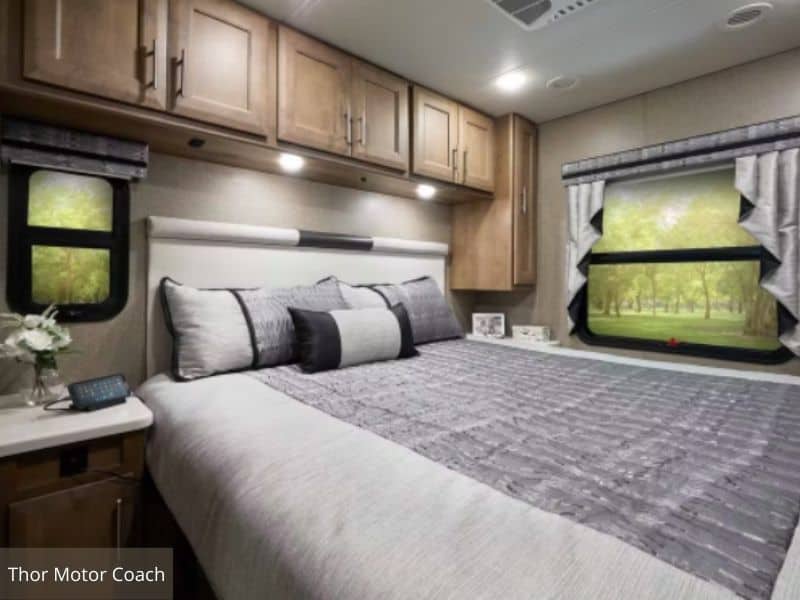
Both queen and king-size beds are available on Class A motorhomes, however, most Class a RVs offer king-size beds, with only the smallest and cheapest Class A RVs offering queen-size beds.
If you’re looking for a Class A motorhome with a king-size bed though, we’ve highlighted some of the most popular Class A RVs with king-size beds below.
Popular Class A RVs with King Size Beds
- Winnebago Sunstar 27P
- Thor Motor Coach Windsport 29M
- Forest River FR3 30DS
- Jayco Precept 31UL
- Coachmen Mirada 35ES
- Forest River Georgetown 7 Series 36K7
- Thor Motor Coach Challenger 37FH
- Coachmen Encore 375RB
- Coachmen Sportscoach SRS 339DS
- Forest River Berkshire XLT 45CA
Do Class A Motorhomes Have Spare Tires?
While you might naturally assume that Class A motorhomes are equipped with a spare tire since just about every vehicle on the road today has a spare tire mounted somewhere on the vehicle.
Surprisingly, most Class A motorhomes do not come standard with a spare tire, as is the case for many RVs.
As RV manufacturers typically choose not to include spare tires, because they state that spare tires for motorhomes are just too heavy and bulky to be practical for an RVer on the side of the road.
However, just because spare tires don’t come standard on most Class A RVs that doesn’t mean that Class A RV owners don’t carry spare tires.
As this is often a debated issue among RV owners on whether to carry a spare tire or not.
As some Class A owners choose to rely on roadside assistance or call for help if they were to incur a flat tire or have a blowout while traveling.
While other Class A owners opt to carry a mounted or unmounted spare tire in the basement of their RV, just in case.
As they rightfully point out that many remote areas, especially out west, have little to no cell phone coverage, which would prevent you from calling for help or roadside assistance.
Do Class A Motorhomes Have Bunk Beds?
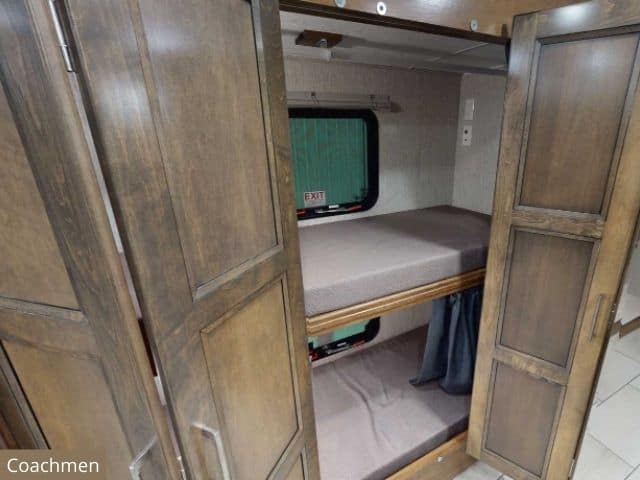
While bunk beds are not available on most Class A motorhomes, there are certain Class A RV models and trim levels that offer bunk beds, which can greatly increase the coach’s sleeping capacity.
However, Class A RV bunk bed models and trim levels can be challenging to find.
So to make things easier, we’ve highlighted some of the most popular Class A motorhome models and trim levels with bunk beds.
Popular Class A Motorhomes with Bunk Beds
- Coachmen Pursuit 31BH
- Winnebago Vista 31B
- Forest River FR3 32DS
- Thor Motor Coach A.C.E. 32.3
- Thor Motor Coach Palazzo 33.5
- Holiday Rambler Vacationer 36F
- Forest River Georgetown Series 7 36K7
- Jayco Precept 36A
- Forest River Berkshire 40F
- Coachmen Sportscoach RD 402TS
Do Class A Motorhomes Have Ovens?
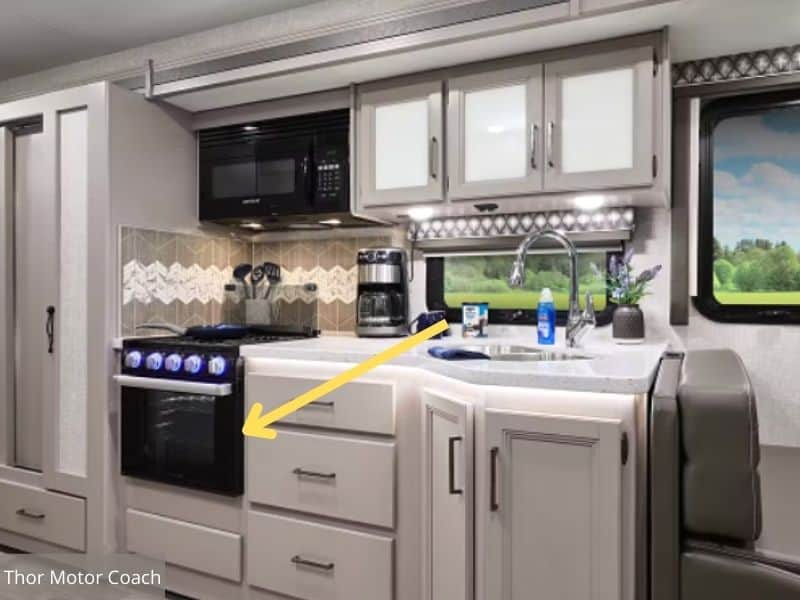
Most Class A motorhomes offer either an oven or a convection microwave oven that will allow you to cook just about any meal on the road that you could make in your kitchen at home.
However, RV ovens and convection microwave ovens due have their limitations and are typically much smaller and much less powerful compared to your large kitchen range/oven at home.
As Class A motorhomes typically have ovens ranging from 17 to 21 inches wide and convection microwave ovens that range from .5 to 1.5 cubic feet in capacity.
Do Class A RVs Have Keyless Entry?
Class A RVs rarely have factory-installed keyless entry, however, there are numerous aftermarket options available, that allow you to retrofit keyless entry on just about any RV, including Class A RVs.
So if you’re looking for an RV with keyless entry or already own an RV and want keyless entry, the best available option is to either install or have an aftermarket keyless entry installed on the RV.
And if you’re not sure which keyless entry to go with, we’ve highlighted the three most popular RV keyless entry options below.
Top 3 RV Keyless Entry Options
- RVLock V4 Keyless Entry Handle with Keypad & Fob – Check Amazon Price
- latch.it RV Keyless Entry Metal Door Lock with 2 Fobs & Backlit Keypad – Check Amazon Price
- CARMTEK RV Keyless Entry Metal Door Lock with 2 Fobs & Backlit Keypad – Check Amazon Price
To see how hard it is to drive a Class A RV, check out our article “Is It Hard to Drive a Class A RV? What You Need to Know“.
Recent Posts
When cruising down the highway in your RV, the last thing you want is a tire blowout! Not only is it dangerous, but RV tire replacement isn't cheap, costing $200 to $300 per tire. The good news,...
Nothing ruins an RV adventure faster than a breakdown with no way to fix it. Because of this, every RVer should have a well-stocked RV tool kit for those unexpected roadside emergencies and campsite...

